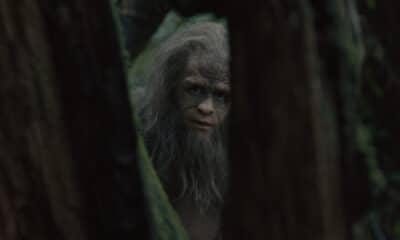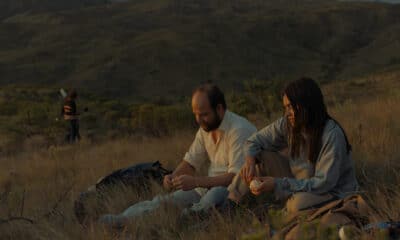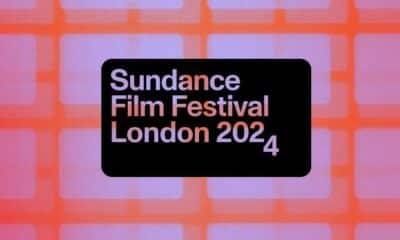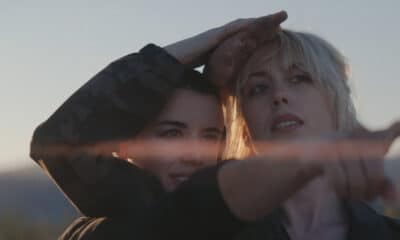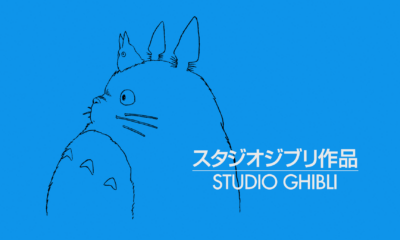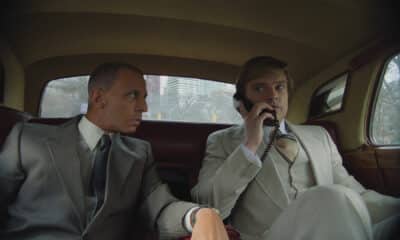This Friday Arrow Video FrightFest begins its first ever digital edition of the festival. The four day event will see over twenty feature films, plus a slew of short films, beamed directly into the homes of horror fans. There’s No Such Thing as Vampires has the honour of opening this year’s (digital) Arrow Video screen and is a fast-paced, synth driven, road movie tale of vampires, which shares more than a little of The Terminator‘s DNA.
With parents that had a strong background in art direction and music, it was surprise that film-maker Logan Thomas caught the film bug. He not only directs the There’s No Such Things as Vampires, but also helped write the script, produce the film, and created its mesmerising score. Considering just how much of the film stems from Thomas himself, he was the perfect person to sit down with to discuss the project.

Both of your parents work with the creative industry, do you think that that helped you make the decision to become a filmmaker?
I think just having it around me may have. I was just drawn to it. I like creating moments that don’t actually exist. It’s kind of like altering time. I think I got obsessed with that first. This idea of creating through sound and image, light and movement… worlds that seemed real, but looked completely non-real. That was my first obsession and it grew from there.
Where did the idea for There’s No Such Thing as Vampires come from, it’s very different to your last feature, The Yellow Wallpaper?
Basically my co-writer and co producer, Aric [Cushing]… we had done The Yellow Wallpaper together. He wanted to do another film in the horror genre and I wasn’t a hundred percent sure I wanted to, or how I felt. I certainly didn’t want to do another slow-burn movie that was a head puzzle film like Yellow Wallpaper. I love that movie, I don’t like repeating myself. So he just kept giving me script ideas. He’s really good at that, really good at just coming up with ideas. You know that Scary Stories to Tell in the Dark? There’s a new book coming out called “Don’t Turn Out the Lights” [by Random House], which is the continuation to that, and one of his stories got in this book that’s coming out this fall. So he’s just a good ideas guy.
He just kept giving me script after script of different ideas. I would read them and go, ‘meh, not interested, don’t want to do that.’ Then he gave me one about a couple of people being out in the desert, basically being stalked in the desert by a Nosferatu or possible vampire. I liked elements of it and I said, ‘there’s a lot of good stuff here, but if we’re going to do this, let’s make it a road movie. Let’s go for it. Let’s combine the other stuff that I would rather do, something closer to the original Mad Max or Terminator, and bring that idea and level of myth to it. If we’re gonna do a vampire story, it’s got to be new. We have to add something new to the vampire myth.’
Near Dark is a terrific film and often an overlooked movie, but it introduced the idea of using vehicles as a real part of how they move and follow rather than flying through the night or doing all that stuff. So that was a big element for me, really just expanding the myth of what these things were. We talked a little bit about how I wanted to go more Lovecraftian and more monstrous. There was no way I was going to do any vampire movies at all unless they’re mean as Hell and scary.

When I sat down to watch the film, I couldn’t help but notice a lot of James Cameron influences in the film, particularly The Terminator. Who else was a source of inspiration?
British filmmakers were actually a huge influence on me when I started learning how to photograph. Both the Scott brothers, Ridley and Tony, Adrian Lyne, Alan Parker, Nic Roeg; they were much more influential on me than American directors. But Jim Cameron is definitely one of the American directors that I grew up with. The way he shoots and the way he presents the story, even if you don’t necessarily like a story that he’s done, the way he executes is really quite phenomenal. George Miller was also a big influence on me.
One of the other similarities outside of the look and feel of The Terminator, is that both films were made fairly modest budgets?
Modest is being kind (laughs) – this was a very tight budget film. Terminator, Mad Max, and Halloween, were made on very little money. What people did was they were inventive. They invented ways to create a similar impact or feeling [to the bigger budgets], and to me it makes it more magical than loads of green scenes and multiple cameras on a rig. That’s a very different kind of manufacturing of a film. This was a much lower budget than Wallpaper, our first feature was a higher budget for sure.
The good thing that comes out of a smaller budget is that is you have all the control over the movie. Which you have to have. If you’re going to make a film you really – as a director – you have to have absolutely all the control. If you don’t, you’re going to get blamed for it anyway. If someone else edits it, or someone else shoots it a certain way, and you let go even if you’re thinking, ‘that’s not how I wanted to shoot or edit’, or someone composes a score that you’re not excited about – too bad. You’re gonna get it so you have to have that understanding and control over the film. On a low budget, you do have that control, but as the budget goes up, the less control you have.
There’s No Such Thing as Vampires has a very distinctive look, which again is different to your previous film. How did you cultivate this aesthetic? Did you always know from the script stage how you wanted it, or did that come later when you saw the locations etc?
I think it actually came together pretty early on. When I’m writing, or reading a script, I immediately start seeing very specific images that, if they excite me enough, I’ll climb a mountain to get that shot that I can see in my head. From there it starts to formulate how it will look. I knew The Yellow Wallpaper would be very de-saturated, and I used a lot paintings by Hieronymus Bosch, and the colours of those paintings, for Yellow Wallpaper. But when I went to do Vampires, I knew this was steel and hard candy. These were the colours. If I could at least get the feeling. They don’t have to be literally those colours, but blue steel and neon and the hard candy. If I can stay within those ideas as I’m photographing it, it will make it all the way down the line to the colour timing and so forth.

One of the stand-out elements for me was that synth score. The film had me almost immediately just down to that score. With it being a road movie, it was nice to have that score sort of driving the action and being a constant for the audience and characters. It was like its own extra character, which is something you don’t see enough these days. With you having a musical background, I’m guessing music is a key component when you make a film, which a lot of other filmmakers seem to forget.
I know, can you imagine the movie Inception without Hans Zimmer’s incredible score on it? I couldn’t. I can’t imagine Jaws without Williams’ score. I can’t imagine Halloween without that terrific timing of the score that John Carpenter made. For me, I think [directing and composing] they are one and the same. I find sometimes, if you’re a director who can write music and do score, there’s a very interesting block with people about that sometimes. If you’re a director who writes, or who acts, and you happen to do both, people applaud that. But if you’re a director who also composes, there’s more of a tipped eyebrow towards it. They go, ‘hmm, that’s nefarious and strange,’ (laughs). People get weird about it, ‘are you a composer or a director?’ but they don’t ask if you’re a writer or a director, am I an actor or a director. Well they’re all part of directing.
A lot of the songs in the film, we got from the Synthwave movement from around the world. NINA and LAU were actually in the UK. I think that Ollie Wride from FM-84 is also from the UK. Marsheaux I think is Greek, and Jessie Frye is here in the States. It’s a very specific sound for the songs. It’s a very specific eighties revival movement that was very inspirational to both Aric and myself while we were shooting and cutting the film. We were both kind of falling in love with this movement of music. So we said, ‘let’s just hunt these people down and get these songs’. Every movie I think, should have at least one original song if you’re going to have songs in a movie. I wrote I’ll Wait, which is the song that plays during the David Lynchian ‘drive through the night’ scene, and also over the end credits.
It definitely has that Brad Fiedel, Vangelis vibe…
It’s funny when you really think back at that time. Scores by Vangelis, Brad Fiedel, Tangerine Dream, and John Carpenter – they weren’t taken as seriously as orchestral scores. For some reason, they were even actually dismissed. I think they’ve only really gotten the full respect they’ve always deserved, in these last couple of years, which is very odd. People were like, ‘nah it’s a synthetic score, it’s not real score,’ not knowing that actually what those composers were doing was laying down the groundwork for an entirely new kind of way to hear music with image. But those people were all definitely influences on the score.
When I was writing the score, I picked a certain number of synthesizers that I knew were used in that era. The patches and the sounds and the synths were used in roughly that era. But then I went back in when I was scoring it, and I would add brass. So you’d get sound deign, which is metal strikes, then the synth patches, which were all from the early to mid-eighties, and an orchestral, which was horns sections that I was laying on top of it.

How was the casting process, I heard you had an interesting caveat for those that got the part?
We did our casting circle for a number of weeks, I think it was six-ten weeks. I remember managers of actors saying, ‘this is a really long casting process for a movie that isn’t a studio-level film’. But most of them knew that we had done Yellow Wallpaper. That had Michael Moriarty, Veronica Cartwright and Juliet Landau, a lot of really good actors in it. So people knew going in that I was going to run them through the ringer for a long time until I get the pair that worked the strongest out of the pool. We would swap each actor out with each other, even including the guys who play Ariel’s friends. We would circle people around and play them off of each other. Put them in rooms together and see what they would do, when they were afraid. It’s amazing how many actors can’t do fear, or lock up. They can do so many other things, but when it comes to being afraid, they just seize up. You wouldn’t think that, you’d think it would be one of the easiest emotions.
Once we got it down, I met each one of them individually. Actors wait so long and work so hard to hear the words, ‘you got the part’, which of course they’re always elated to hear. Which is wonderful. It’s always a nice thing to see. There’s so many people you have to say no to, and that’s really heartbreaking to watch people go through that. So they got it and then I said, ‘bad news is, because of the way the budget is set up and how many shots and locations I need to get for this film to move as fast as I want it to move, you’re going to have to remain looking the same for two years. I’m going to do principal photography and then over the course of the next year, year and a half afterwards, I am going to ask you to come back just to get one or two shots off in a far off location.’ Shots that we would never have been able to do in principal photography. We could never spend a whole day to drive off and get two great shots. That was never going to happen. You need multiple crews, multiple units to do that. We were trying to shoot location-wise, like a big budget movie. In terms of getting so many shots, locations, and cutaways and inserts, but on a very small budget. So they stop and look at you for a moment like, ‘are you kidding?’ and then they go, ‘no problem, I’ll do it’, because they thought we’d never actually do that, but we did. Everyone came back a couple of times over the course of a year and a half to do a couple of scenes or shots.
The stuff at the end with Emma [Holzer] where there’s a mausoleum, we couldn’t go way out to shoot some of these shoots originally. We did the ending during principal photography, but to get those extra shorts it was really, really far away. So she came back with her hair exactly the same and we went out and shot those exteriors. It was great. They really hung in there on what was a really tough film… When you see them in the car and the other machine is swerving around behind them, they’re really in a car, and we’re really swerving around behind them. There’s a camera strapped to the hood, I’m up in the RV with a camera strapped to me shooting down. We’re going slower, I under-cranked the film. Then on the wide-shots, when they’re aggressively swinging, those are stunt-people. Those were stunt people from LA doing that because we were all going really, really fast. I’m hanging out of the back of a Camaro believe it or not. It was brutal. They really went through it on that one. I adore them, I got lucky with a great cast and a really good experience across the board.

The film has scope for a sequel, is that something that you’re working on?
Yes. We have drafted out the next story part of the story, the “sequel”. I’ll keep shaping that and working on that and see how it feels. Because you never know, will we do a sequel? But we’re also crafting a small series. If the sequel can’t be financially possible, maybe a series could be. Go to Netflix or Amazon and do an 8-13 episode series, sort of softly rebooting the film, whilst at the same time moving forward with the entire story.
The film is screening as part of FrightFest’s first ever digital festival, how are you feeling about the screening?
It’s also screening at Dances with Films in LA the same weekend as FrightFest, then a couple of festivals after that: FilmQuest and CineFest, which has been pushed back later. It was supposed to be in festivals all through this year, but because of Covid a lot of festivals have cancelled and fallen apart, or just don’t know how to handle it. The fact that FrightFest and Dance with Films have even figured out how to handle this, is miraculous. It can’t be easy.
I love London, so I would have loved to come back and see it on the big screen. The small groups I’ve seen it with… it’s always a rush when those few moments happen and everyone in the room literally jumps out of their skin. It would have been nice to have been in a theatre. Just the general overall feeling of the film would have been fun to gauge a good sized audience on. But alas it will have to wait I think. I’m just glad we’re there at all.
People are currently selected their line-up’s, why should they opt for There’s No Such Thing As Vampires?
It’s just a real lean, fast, fun film that makes you feel kind of good when it’s done. That’s how I felt after I watched the first Terminator; a little melancholy, but I felt like I’d really been through something. I was a little jazzed and pumped with adrenaline by the movie, and that’s what I think this film is.
There’s No Such Thing as Vampires screens at Arrow Video FrightFest on Friday 28th August 2020. You can purchase tickets here.
Kat Hughes is a UK born film critic and interviewer who has a passion for horror films. An editor for THN, Kat is also a Rotten Tomatoes Approved Critic. She has bylines with Ghouls Magazine, Arrow Video, Film Stories, Certified Forgotten and FILMHOUNDS and has had essays published in home entertainment releases by Vinegar Syndrome and Second Sight. When not writing about horror, Kat hosts micro podcast Movies with Mummy along with her five-year-old daughter.

Latest Posts
-


Apple TV
/ 19 hours agoTrailer: André Holland leads Apple’s new limited series, ‘The Big Cigar’
Apple TV+ has released the full trailer for The Big Cigar, a new, six-episode...
By Paul Heath -


Film News
/ 19 hours agoUK trailer, poster and release date for Sundance smash ‘Sasquatch Sunset’
Premiering in the UK at the Sundance London event in June is the brilliant...
By Paul Heath -


Disney+
/ 21 hours agoNew trailer for ‘Becoming Karl Lagerfeld’ with Daniel Brühl
A trailer has landed for the June-released Becoming Karl Lagerfeld, the Disney+/ Hulu series...
By Paul Heath -


Film News
/ 21 hours agoUK release date revealed for Cannes film ‘The Delinquents’
MUBI has announced the release date for The Delinquents, the Cannes Un Certain Regard-premiering...
By Paul Heath


